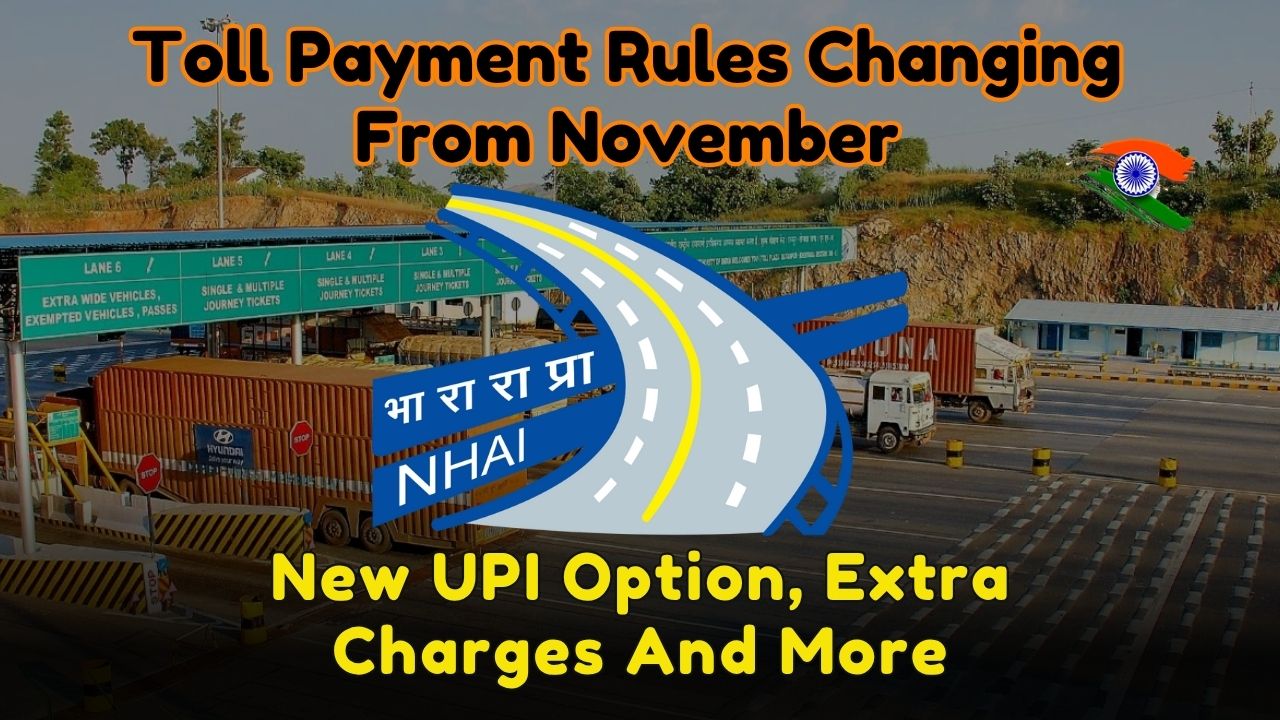If you often travel on national highways for work, business, or family trips, you need to be aware of the upcoming changes in toll payment rules. Starting from 15 November 2025, the National Highways Authority of India is introducing an additional digital payment option to make toll collection smoother and reduce dependence on cash.
Until now, road users primarily relied on FASTag or cash payments at toll plazas. While FASTag has already covered a large share of toll transactions, many vehicle owners still faced issues whenever the tag failed to scan or when there were technical glitches. In such situations, they were often forced to pay double toll in cash, leading to unnecessary financial burden.
To address these concerns and further strengthen the digital ecosystem, NHAI has now approved UPI based toll payments as a backup option in case FASTag transactions do not go through successfully.
What Changes In Toll Payment From November 15
From 15 November 2025, three payment options will be available at toll plazas across India
- FASTag
- UPI based payment
- Cash payment
FASTag will continue to remain the primary and preferred payment mode. However, if a genuine attempt to pay through FASTag fails due to technical reasons, you will now have the option to pay via UPI instead of being forced to pay double toll in cash.
This change is especially important for frequent travelers who may have experienced situations where their tag was valid and loaded with balance, but the scanner failed to read it, resulting in disputes and extra charges.
Short Summary Table
Point |
Details |
|---|---|
Implementing Authority |
National Highways Authority of India |
Effective Date |
15 November 2025 |
New Payment Option |
UPI based toll payment if FASTag fails |
Extra Charge With UPI |
Normal toll amount plus 25 percent |
Cash Payment Rule |
Double toll amount payable in case of cash |
Primary Objective |
Promote digital payments and reduce cash at toll plazas |
Key Requirement For Users |
Keep FASTag KYC updated and maintain sufficient balance |
Official Information Website |
New UPI Option When FASTag Payment Fails
Earlier, toll plazas allowed only two modes of payment, which were FASTag and cash. If the toll operator claimed that FASTag did not work or the system showed an error, the vehicle owner typically had no choice but to pay in cash, often at double the usual toll rate.
Under the new rules
- If the FASTag scan fails, you can make the payment using any UPI app such as PhonePe, Google Pay, Paytm, or banking apps.
- The toll amount in this case will be the regular toll plus an additional 25 percent.
- This means that while you pay slightly more than the normal FASTag toll, you avoid the heavy penalty of double toll that applies to cash users.
This arrangement is intended to provide practical relief to genuine FASTag users who face one off technical issues, while still discouraging those who intentionally avoid using digital modes.
How Much Will You Pay With FASTag, UPI, Or Cash
To understand the cost difference clearly, consider a simple example where the regular toll for a particular highway stretch is 100 rupees.
- If the FASTag transaction is successful, the amount deducted from your FASTag wallet or linked account will be 100 rupees.
- If FASTag fails and you choose to pay via UPI, the toll payable will be 125 rupees.
- If you insist on paying in cash or have no digital option, you will have to pay double toll, which means 200 rupees.
So in this example
- FASTag is the cheapest method at 100 rupees.
- UPI as a backup is costlier but still significantly better than cash at 125 rupees.
- Cash payment turns out to be the most expensive at 200 rupees.
Through this structure, the government aims to reduce cash usage at toll plazas, speed up vehicle movement, and promote a fully digital toll collection environment.
Why The Toll Rules Have Been Changed
The government has been consistently promoting digital transactions in every sector. Highways are no exception. According to official data, around 98 percent of toll payments in India are already made using FASTag. This high adoption has reduced congestion and made toll plazas more efficient.
However, a small portion of vehicles still rely on cash either due to lack of awareness, refusal to adopt FASTag, or occasional technical issues. Handling cash at toll plazas leads to several problems such as
- Longer waiting times and queues
- Higher operational costs for toll operators
- Greater risk of error or miscount
- Reduced transparency compared to digital records
By adding UPI as a third digital option, NHAI wants to bring even those remaining vehicle owners into the digital net. This is expected to further simplify toll collection and reduce disputes related to FASTag failure and cash penalties.
When And Where Will The New Rules Apply
NHAI has clarified that the new toll payment rules will be applicable across India from 15 November 2025. Before the nationwide rollout, the UPI system has already been tested at selected toll plazas to ensure that the infrastructure is ready.
In the next phase, UPI QR codes or other compatible interfaces will be placed at all toll booths, allowing quick scanning and payment. The idea is to make the process as seamless as possible so that even when FASTag fails, the vehicle does not get stuck at the plaza for long.
Important Precautions For FASTag Users
Even though UPI is being introduced as a backup, FASTag will remain the primary toll payment method. Therefore, vehicle owners should take the following steps
- Ensure that FASTag KYC details are complete and updated.
- Check the validity and status of the tag periodically through the MyFASTag app or the respective bank portal.
- Maintain adequate balance in the linked wallet or account before starting a long journey.
- Monitor SMS alerts and app notifications to track all toll deductions.
NHAI has already announced that FASTag accounts with incomplete KYC will be blocked. If your tag has not been used for a long time or you have not updated your details after a bank migration or mobile number change, you should take immediate action.
What To Do If You Do Not Have A FASTag Yet
If you still do not have a FASTag, it is advisable to get one at the earliest. You can purchase FASTag through
- Authorized partner banks and their branches
- Digital payment platforms such as Paytm and PhonePe
- Online marketplaces like Amazon Pay and other approved intermediaries
The usual process involves
- Entering your vehicle number and basic details.
- Uploading required documents if asked.
- Completing OTP based verification.
- Activating the tag and sticking it on the windscreen as instructed.
Once activated, you can recharge the FASTag wallet or link it to your bank account. Recharges and top ups can be done within seconds through mobile apps or net banking.
NHAI’s Safety And Fraud Prevention Advice For Travelers
Along with updating payment options, NHAI has issued some important safety and security guidelines for road users
- Always check your FASTag balance before starting a trip, especially if you are planning a long drive with multiple toll plazas.
- Use only the official MyFASTag app, bank applications, or trusted digital platforms for recharge and KYC updates.
- Avoid clicking on unknown links or making payments on fake websites that claim to offer FASTag services or discounts.
- If your FASTag repeatedly shows scan failed at multiple tolls even after having sufficient balance, contact customer support or replace the tag as soon as possible.
Being cautious with digital payments will help you avoid fraud while continuing to enjoy faster and more convenient toll transactions.
Frequently Asked Questions (FAQs)
Q1. From which date will the new UPI based toll payment rule start
The new rule allowing UPI payment as a backup option when FASTag fails will be implemented from 15 November 2025 across toll plazas in India, as per NHAI guidelines.
Q2. Will I still have to pay double toll if FASTag fails
If your FASTag fails and you choose to pay using UPI, you will not be charged double toll. Instead, you will pay the regular toll plus a 25 percent additional amount. Double toll will continue to apply in case of cash payments.
Q3. Is it compulsory to have FASTag if UPI is now allowed
FASTag remains the primary and preferred payment mode at toll plazas. UPI is provided only as a backup option when FASTag does not work. It is still recommended and practically necessary to keep a valid FASTag on your vehicle.
Q4. How can I check whether my FASTag KYC is updated
You can check the status of your FASTag and KYC details through the MyFASTag app or the portal or app of the bank that issued your tag. If it shows KYC incomplete or blocked, you must submit or update your documents immediately.
Q5. Where can I find official information about toll rules and FASTag updates
For official notifications, guidelines, and updates regarding toll payment rules and FASTag usage, you should refer to the National Highways Authority of India website at https://nhai.gov.in and the official MyFASTag related portals.
For More Information Click HERE








